
Salvia apiana, the Californian white sage, bee sage, or sacred sage is an evergreen perennial shrub that is native to the southwestern United States and northwestern Mexico, found mainly in the coastal sage scrub habitat of Southern California and Baja California, on the western edges of the Mojave and Sonoran deserts.
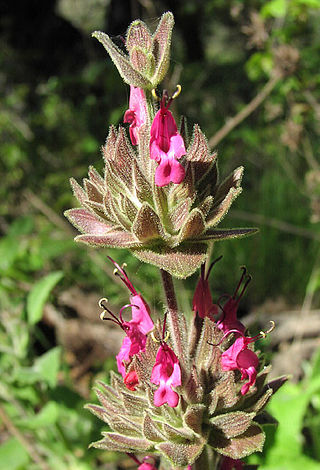
Salvia spathacea, the California hummingbird sage or pitcher sage, is a species of flowering plant in the family Lamiaceae, native to southern and central California growing from sea level to 610 m (2,001 ft). This fruity scented sage blooms in March to May with typically dark rose-lilac colored flowers. It is cultivated in gardens for its attractive flowering spikes and pleasant scent.

Salvia glutinosa, the glutinous sage, sticky sage, Jupiter's sage, or Jupiter's distaff, is a herbaceous perennial plant belonging to the family Lamiaceae.

Salvia leucophylla, the San Luis purple sage or gray sage, is an aromatic sage native to the southern coastal mountain ranges of the Californias.

Salvia columbariae is an annual plant that is commonly called chia, chia sage, golden chia, or desert chia, because its seeds are used in the same way as those of Salvia hispanica (chia). It grows in California, Nevada, Utah, Arizona, New Mexico, Sonora, and Baja California, and was an important food for Native Americans. Some native names include pashiiy from Tongva and it'epeš from Ventureño.
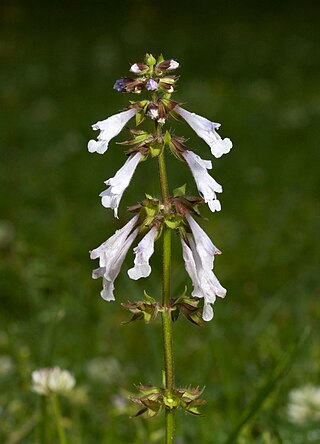
Salvia lyrata, is a herbaceous perennial in the family Lamiaceae that is native to the United States, from Connecticut west to Missouri, and in the south from Florida west to Texas. It was described and named by Carl Linnaeus in 1753.

Salvia pratensis, the meadow clary or meadow sage, is a species of flowering plant in the family Lamiaceae, native to Europe, western Asia and northern Africa. The Latin specific epithet pratensis means "of meadows", referring to its preferred habitat. It also grows in scrub edges and woodland borders.

Correa alba, commonly known as white correa, is a species of shrub that is endemic to south-eastern Australia. It has egg-shaped to more or less circular leaves, erect white flowers arranged singly or in groups on short side branches, and green fruit.

Salvia farinacea, the mealycup sage, or mealy sage, is a herbaceous perennial native to Nuevo León, Mexico and parts of the United States including Texas and Oklahoma. Violet-blue spikes rest on a compact plant of typically narrow salvia-like leaves; however, the shiny leaves are what set this species apart from most other Salvia, which bear velvety-dull leaves.
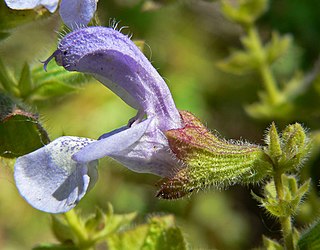
Salvia africana is a heavy branched aromatic perennial shrub native to the coast of the Cape Provinces of South Africa, found on coastal dunes and in nearby rocky hills up to 600 m elevation. It grows to 60–90 cm, with round grayish stems covered with hairs that release a strong scent when brushed. The leaves are a soft grey-green, lighter on the underside, and elliptical shaped. The inflorescences reach 30 cm long, with 2-6 flowers in each whorl, ranging from pale blue to pale violet or pink.

Salvia brandegeei is a perennial evergreen shrub in the mint family known by the common names Santa Rosa Island sage or Brandegee's sage. It is a fragrant plant characterized by lavender flowers and dark green leaves. For many years, it was thought to be native only to Santa Rosa Island, one of the Channel Islands of California, until it was discovered along the coast of Baja California. It is threatened by development and mining along the mainland portions of its range, but otherwise has a stable population on Santa Rosa Island.

Salvia corrugata is a perennial shrub native to Colombia, Peru, and Ecuador, growing at 8000–9800 ft elevation. It was brought into horticulture about 2000 as a result of a collecting trip to South America in 1988. All the plants in cultivation today are from six seeds that germinated from that trip.

Salvia disermas is a herbaceous perennial shrub native to South Africa, found in streambeds, moist forest, grassland, and disturbed ground. It was originally specified as rugosa, but was changed to disermas. It grows throughout west Africa, with its greatest concentration in South Africa, where it is used medicinally as a tea, and as a lotion for treating sores.

Salvia is the largest genus of plants in the sage family Lamiaceae, with nearly 1000 species of shrubs, herbaceous perennials, and annuals. Within the Lamiaceae, Salvia is part of the tribe Mentheae within the subfamily Nepetoideae. One of several genera commonly referred to as sage, it includes two widely used herbs, Salvia officinalis and Salvia rosmarinus.

Salvia namaensis is an evergreen perennial shrub native to a limited area in Namibia and a wide area of South Africa. It is typically found growing on rocky slopes, shales, limestone hills, and sandy soils at 1,000 to 5,000 feet elevation. The specific epithet namaensis probably refers to the Nama tribe which is indigenous to Namaqualand, the region in Namibia where the plant grows.

Salvia patens, the gentian sage or spreading sage, is a species of flowering plant in the sage family Lamiaceae that is native to a wide area of central Mexico. This herbaceous perennial was introduced into horticulture in 1838 and popularized a hundred years later by the Irish gardener and botanist William Robinson (1838-1935).
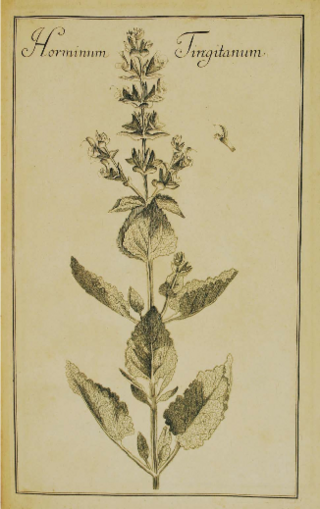
Salvia tingitana is an herbaceous perennial in the family Lamiaceae. It has a long and enigmatic history—it has been grown and described since the 17th century without any certainty about its origin. Botanists' speculation that it was native to northern Africa is reflected in the specific epithet tingitana, which refers to the town of "Tingi", even though no native plants have ever been found there. It was not until 1989 that a wild population of the plant was discovered, in western Saudi Arabia. The plant is regarded as a rather strong mosquito repellent commonly used in traditional medicine of Behbahan where it blooms around March.

Salvia stenophylla is a perennial shrub native to a wide area of Southern Africa: South Africa, Botswana and Namibia. It grows on grassy or stony slopes, and in open countryside or among shrubs. It has been used traditionally as a disinfectant by burning it in huts after sickness, and it is also mixed with tobacco for smoking. Its specific epithet, stenophylla, refers to the narrow leaves.
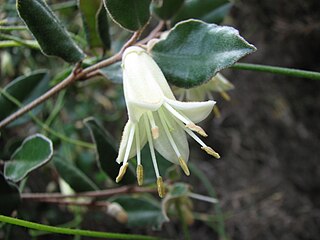
Correa backhouseana is a species of rounded shrub that is endemic to coastal and near-coastal areas of southern Australia. It has elliptical to egg-shaped or round leaves that are densely hairy on the lower surface, and cylindrical to funnel-shaped, cream-coloured to pale green or red and yellow flowers.

Protorhus longifolia, the red beech, is a medium to large, mostly dioecious species of tree in the family Anacardiaceae. It is native to South Africa and Eswatini, where it occurs in well-watered situations from coastal elevations to 1,250 m. The leafy, evergreen trees have rounded crowns and usually grow between 6 and 10 m tall, but regularly taller in forest.




















